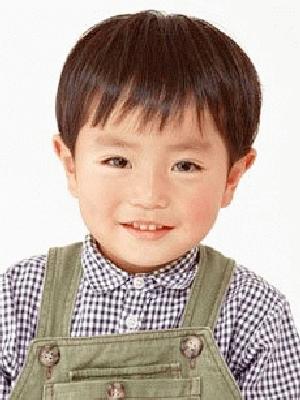
Chinese Boys' Hair Styles

Figure 1.--An important style for children, both boys and girls since the Revolution has been square cut bangs. We are not sure when this style first became popualar. WE do note that boys are more likely to wear theior hair combed into a front fring while girls are more likelt to have the front frimge cut into classic straight across.
|
|
At this time we still have varied limited information on Chinese hair styles and how they cahanged over time. Chinese boys and men until the Revolution were fanous for wearing plaited pigtails. This was a fashion introduced by the Manchus in the 17th century. Originally it was a sign of submision demanded by the first Manchu Emperor only one year after seizing the throne in 1645. Chinese men shaved the front of their head, then combed the back hair into braids. They used not only their own natural hair, but also horsehair or black silk. The Chinese came to see their braided pigtails a sign of dignity and manhood. For the Chinese, to pull on another's pigtails was a great insult. I am not sure to what extent boys wore them or just at what age a Chinese boy began to grow his pigtail. Unmarried Chinese girls also often wore their hair in pigtails. It was a pervasive style in the 19th century. Most Chinese immigrants that came to America in the 19th century had these plaited pigtails. An important style for children, both boys and girls since the Revolution has been square cut bangs. We are not sure when this style first became popular. We do note that boys are more likely to wear theior hair combed into a front fringe while girls are more likely to have the front fringe cut into classic straight across bangs.
Chronology
At this time we still have varied limited information on Chinese hair styles and how they cahanged over time. Chinese boys and men until the Revolution were fanous for wearing plaited pigtails.
Styles
The two hair styles most associated with China are pigtails and bangs.
This was a fashion introduced by the Manchus in the 17th century. Originally it was a sign of submision demanded by the first Manchu Emperor only one year after seizing the throne in 1645. Chinese men shaved the front of their head, then combed the back hair into braids. They used not only their own natural hair, but also horsehair or black silk. The Chinese came to see their braided pigtails a sign of dignity and manhood. For the Chinese, to pull on another's pigtails was a great insult. I am not sure to what extent boys wore them or just at what age a Chinese boy began to grow his pigtail. Unmarried Chinese girls also often wore their hair in pigtails. It was a pervasive style in the 19th century. Most Chinese immigrants that came to America in the 19th century had these plaited pigtails. We notice that many boys wearing pigtails look like their forehead has been shaved.
Bangs
An important style for children, both boys and girls since the Revolution has been square cut bangs. This is virtually the opposite of the pigtail style that was so pervasive for so many years in which boys had shaved foreheads. We are not sure when the bangs style first became popular. We do note that boys are more likely to wear their hair combed into a front fringe while girls are more likelt to have the front fringe cut into classic straight across bangs.
HBC

Related Chronolgy Pages in the Boys' Historical Web Site
[The 1880s]
[The 1890s]
[The 1900s]
[The 1910s]
[The 1920s]
[The 1930s]
[The 1940s]
[The 1930s]
[The 1940s]
[The 1950s]
[The 1960s]
[The 1970s]
[The 1980s]
Related Style Pages in the Boys' Historical Web Site
[Long pants suits]
[Knicker suits]
[Short pants suits]
[Socks]
[Eton suits]
[Jacket and trousers]
[Blazer]
[School sandals]
[School smocks]
[Sailor suits]
[Pinafores]
[Long stockings]
Navigate the Boys' Historical Clothing Web Page
[Return to the Main Chinese country page]
[Introduction]
[Activities]
[Biographies]
[Chronology]
[Clothing styles]
[Countries]
[Bibliographies]
[Contributions]
[FAQs]
[Glossaries]
[Images]
[Links]
[Registration]
[Tools]
[Boys' Clothing Home]
Created: August 28, 2001
Last updated: March 25, 2004



